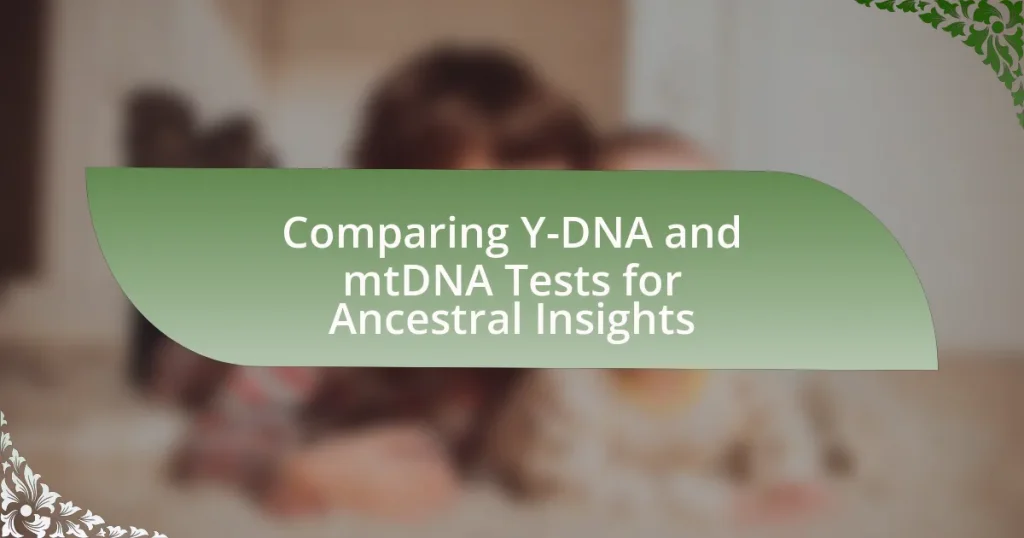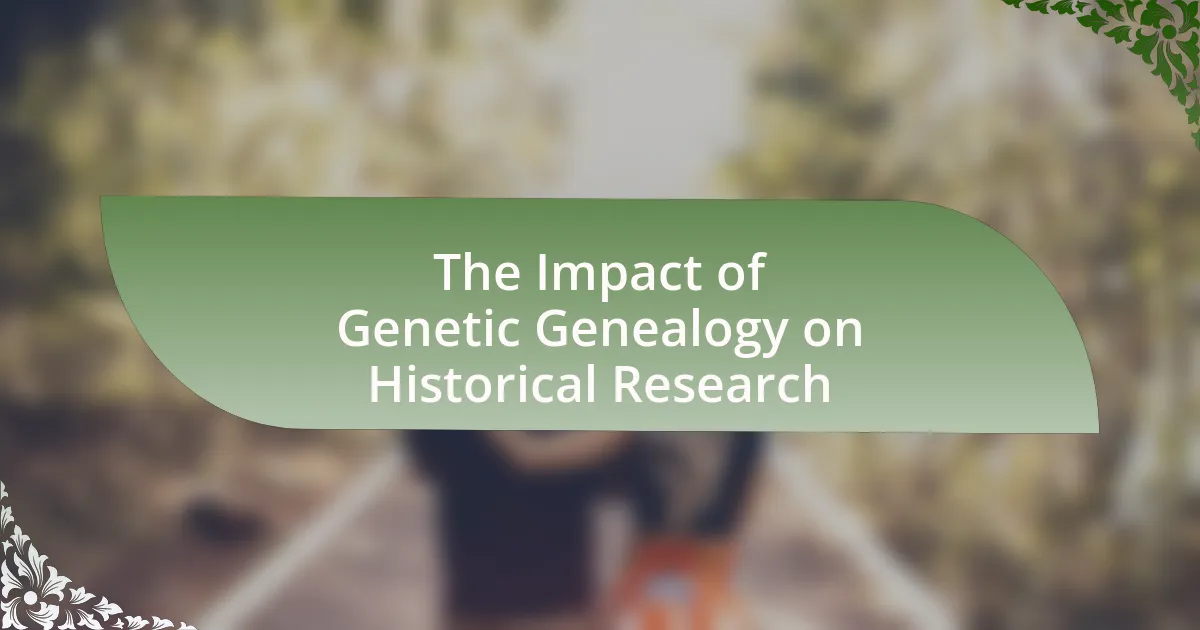Y-DNA and mtDNA tests are genetic analyses used to trace ancestry through paternal and maternal lines, respectively. Y-DNA tests focus on the Y chromosome, inherited from father to son, providing insights into male lineage and migration patterns, while mtDNA tests analyze mitochondrial DNA, passed from mother to child, to explore maternal ancestry. The article details the methodologies, specific genetic markers, advantages, limitations, and the types of ancestral information derived from each test. It also discusses practical considerations for individuals choosing between Y-DNA and mtDNA testing based on their ancestry research goals, costs, and expected timeframes for results.
What are Y-DNA and mtDNA Tests?

Y-DNA and mtDNA tests are genetic tests that analyze specific types of DNA to trace ancestry. Y-DNA tests examine the Y chromosome, which is passed from father to son, allowing for the study of paternal lineage. In contrast, mtDNA tests analyze mitochondrial DNA, inherited from the mother, to explore maternal ancestry. These tests provide insights into ancestral origins and migration patterns, with Y-DNA focusing on male lineage and mtDNA on female lineage.
How do Y-DNA and mtDNA tests differ in their methodologies?
Y-DNA and mtDNA tests differ primarily in the type of DNA they analyze and their inheritance patterns. Y-DNA tests focus on the Y chromosome, which is passed from father to son, allowing for the tracing of paternal lineage. In contrast, mtDNA tests analyze mitochondrial DNA, which is inherited maternally, enabling the tracing of maternal ancestry. This fundamental difference in inheritance means that Y-DNA can only provide insights into male lineage, while mtDNA can reveal information about both male and female ancestors through the maternal line.
What specific genetic markers are analyzed in Y-DNA tests?
Y-DNA tests specifically analyze short tandem repeats (STRs) and single nucleotide polymorphisms (SNPs) on the Y chromosome. STRs are repeated sequences of DNA that vary in length among individuals, and they are used to determine paternal lineage and ancestry. SNPs, on the other hand, are variations at a single nucleotide position in the DNA sequence, which provide insights into deeper ancestral origins and population migrations. These markers are crucial for tracing male lineage and understanding genetic heritage.
What specific genetic markers are analyzed in mtDNA tests?
Mitochondrial DNA (mtDNA) tests analyze specific genetic markers known as hypervariable regions (HVRs), particularly HVR1 and HVR2, as well as coding region variations. These markers are crucial for tracing maternal lineage and understanding ancestral origins. The hypervariable regions are highly polymorphic, allowing for differentiation between individuals, while coding region variations provide insights into deeper ancestral connections and population migrations.
What are the primary purposes of Y-DNA and mtDNA tests?
Y-DNA and mtDNA tests primarily serve to trace paternal and maternal lineages, respectively. Y-DNA tests analyze the Y chromosome, which is passed from father to son, allowing individuals to explore their direct male ancestry and identify paternal haplogroups. In contrast, mtDNA tests examine mitochondrial DNA, inherited from the mother, enabling individuals to trace their maternal lineage and identify maternal haplogroups. These tests provide insights into ancestral origins, migration patterns, and genetic relationships, contributing to a deeper understanding of family history and heritage.
How does Y-DNA testing contribute to paternal lineage tracing?
Y-DNA testing contributes to paternal lineage tracing by analyzing the Y chromosome, which is passed down from father to son unchanged, allowing for the identification of direct male ancestors. This testing can reveal genetic markers that are unique to specific paternal lineages, enabling individuals to trace their ancestry back through generations. Studies have shown that Y-DNA can connect individuals to specific geographic regions and historical populations, providing insights into paternal heritage and migration patterns.
How does mtDNA testing contribute to maternal lineage tracing?
mtDNA testing contributes to maternal lineage tracing by analyzing mitochondrial DNA, which is inherited exclusively from the mother. This unique inheritance pattern allows researchers to trace maternal ancestry through generations, as mtDNA remains relatively stable over time with only minor mutations. Studies have shown that mtDNA can reveal connections to maternal relatives and ancestral populations, providing insights into maternal heritage and migration patterns. For example, the analysis of mtDNA haplogroups can identify specific maternal lineages, helping individuals understand their ancestral roots more clearly.
What are the advantages and limitations of each test?
Y-DNA tests provide advantages such as paternal lineage tracing and a larger number of markers for deeper ancestral insights, while their limitations include being applicable only to males and not providing information about maternal ancestry. In contrast, mtDNA tests offer insights into maternal lineage and can be conducted on both males and females, but they have limitations in resolution and can only trace back a limited number of generations.
What are the key benefits of Y-DNA testing?
Y-DNA testing offers several key benefits, primarily in tracing paternal lineage and understanding ancestral origins. This type of testing specifically analyzes the Y chromosome, which is passed down from father to son, allowing individuals to uncover their direct male ancestry. Additionally, Y-DNA testing can identify genetic matches with other individuals, facilitating connections with distant relatives and expanding family trees. It also provides insights into historical migration patterns and can reveal connections to specific geographic regions or ethnic groups, enhancing the understanding of one’s heritage.
What are the key benefits of mtDNA testing?
The key benefits of mtDNA testing include the ability to trace maternal lineage, identify ancestral origins, and provide insights into genetic health risks. mtDNA testing specifically analyzes mitochondrial DNA, which is inherited exclusively from the mother, allowing individuals to uncover their maternal ancestry with high accuracy. This type of testing can reveal connections to specific populations and migration patterns, enhancing understanding of one’s heritage. Additionally, mtDNA testing can help identify potential genetic predispositions to certain diseases, as variations in mitochondrial DNA have been linked to various health conditions.
What limitations should be considered for Y-DNA testing?
Y-DNA testing has several limitations that should be considered, including its inability to provide a complete ancestral picture, as it only traces paternal lineage. This means that Y-DNA tests cannot reveal maternal ancestry or the contributions of female ancestors, which can lead to an incomplete understanding of one’s heritage. Additionally, Y-DNA testing is limited to males, as only individuals with a Y chromosome can undergo this type of testing. Furthermore, the interpretation of Y-DNA results can be complicated by the presence of non-paternity events, such as adoptions or infidelity, which may obscure true lineage. Lastly, the database of Y-DNA results may not be extensive enough to provide meaningful connections for all individuals, particularly those from underrepresented populations, limiting the potential for discovering relatives or ancestral origins.
What limitations should be considered for mtDNA testing?
mtDNA testing has several limitations that should be considered, including its inability to provide detailed ancestral information beyond maternal lineage, potential for homoplasmy which can obscure results, and the fact that it does not reflect the genetic contributions from paternal ancestors. Additionally, mtDNA is inherited only through the maternal line, which means it cannot trace lineage through males, limiting its scope for comprehensive ancestry analysis. Furthermore, the mutation rate of mtDNA is relatively low, which can make it difficult to distinguish between closely related individuals over generations. These factors collectively restrict the interpretative power of mtDNA testing in genealogical research.
How do Y-DNA and mtDNA tests provide ancestral insights?

Y-DNA and mtDNA tests provide ancestral insights by analyzing specific genetic markers passed down through paternal and maternal lines, respectively. Y-DNA tests trace lineage through the Y chromosome, which is inherited only by males, allowing researchers to identify paternal ancestry and connections to historical populations. In contrast, mtDNA tests examine mitochondrial DNA, which is passed from mothers to all their children, enabling the exploration of maternal ancestry and the identification of maternal haplogroups. These tests can reveal migration patterns, ancestral origins, and connections to ancient populations, supported by databases that compare genetic sequences to known lineages and historical records.
What types of ancestral information can be derived from Y-DNA tests?
Y-DNA tests provide information about paternal lineage and ancestral origins through the analysis of the Y chromosome, which is passed from father to son. These tests can reveal the individual’s haplogroup, indicating their deep ancestral roots and migration patterns, as well as potential connections to specific geographic regions or ethnic groups. Additionally, Y-DNA tests can identify genetic matches with other individuals, helping to trace family connections and build paternal family trees. This information is supported by genetic studies that demonstrate the stability of Y-DNA markers over generations, making them reliable for tracing paternal ancestry.
How can Y-DNA results reveal migration patterns of paternal ancestors?
Y-DNA results can reveal migration patterns of paternal ancestors by analyzing specific markers on the Y chromosome that are passed down from father to son. These markers can indicate genetic similarities among individuals, allowing researchers to trace lineage and identify common ancestors. For instance, studies have shown that certain haplogroups, which are groups of similar Y-DNA sequences, correlate with geographic regions, thus providing insights into historical migration routes. Genetic data from Y-DNA testing has been used to map the movement of populations, such as the spread of the R1b haplogroup across Europe, which is linked to the migration of early farmers from the Near East. This evidence supports the understanding of how paternal lines have traversed different regions over time, illustrating the migration patterns of ancestors.
What can Y-DNA tests tell us about ancient human populations?
Y-DNA tests can reveal the paternal lineage and migration patterns of ancient human populations. By analyzing specific markers on the Y chromosome, researchers can trace the ancestry of male individuals back thousands of years, identifying distinct haplogroups that correspond to geographic regions and historical events. For instance, studies have shown that certain Y-DNA haplogroups are linked to the spread of agriculture in Europe around 8,000 years ago, indicating how ancient populations migrated and interacted. This genetic information provides insights into the demographic history and social structures of early human societies.
What types of ancestral information can be derived from mtDNA tests?
Mitochondrial DNA (mtDNA) tests can provide information about maternal lineage, including the identification of maternal ancestors and the tracing of direct maternal ancestry. These tests analyze the mtDNA, which is inherited exclusively from the mother, allowing individuals to uncover their maternal haplogroup, a group of similar mtDNA sequences that share a common ancestor. This can reveal geographic origins and migration patterns of maternal ancestors, as specific haplogroups are often associated with particular regions or populations. Studies have shown that mtDNA can trace back thousands of years, providing insights into ancient human migrations and the historical context of maternal ancestry.
How can mtDNA results reveal migration patterns of maternal ancestors?
mtDNA results can reveal migration patterns of maternal ancestors by tracing the maternal lineage through mitochondrial DNA, which is inherited exclusively from mothers. This type of DNA remains relatively stable over generations, allowing researchers to identify specific haplogroups that correspond to geographic regions. For instance, studies have shown that certain mtDNA haplogroups are prevalent in specific populations, indicating historical migration routes. By analyzing the distribution of these haplogroups across different populations, scientists can reconstruct the movement of maternal ancestors, providing insights into their migration patterns and historical demographics.
What can mtDNA tests tell us about maternal lineage and heritage?
mtDNA tests can reveal information about maternal lineage and heritage by tracing the maternal ancestry through mitochondrial DNA, which is passed down from mothers to their children. This type of DNA testing allows individuals to identify their maternal haplogroup, which reflects shared ancestry with others who have the same genetic lineage. Studies have shown that mtDNA can provide insights into ancient migrations and population histories, as it remains relatively stable over generations. For example, research published in the American Journal of Human Genetics indicates that mtDNA analysis can trace back maternal lineages thousands of years, linking individuals to specific geographic regions and historical populations.
What should individuals consider when choosing between Y-DNA and mtDNA tests?

Individuals should consider their specific ancestry research goals when choosing between Y-DNA and mtDNA tests. Y-DNA tests trace paternal lineage through the Y chromosome, which is passed from father to son, making it suitable for those interested in exploring their male ancestry. In contrast, mtDNA tests analyze mitochondrial DNA, inherited from the mother, allowing individuals to investigate their maternal lineage.
Additionally, the scope of the family tree being researched is crucial; Y-DNA is limited to direct male descendants, while mtDNA covers all maternal lines. The type of information desired also matters; Y-DNA can provide insights into surname origins and paternal haplogroups, whereas mtDNA can reveal ancient maternal ancestry and migration patterns.
Ultimately, the choice hinges on whether the individual seeks to explore their paternal or maternal lineage, as well as the specific insights they wish to gain from their ancestry research.
How do personal goals influence the choice between Y-DNA and mtDNA testing?
Personal goals significantly influence the choice between Y-DNA and mtDNA testing by determining the type of ancestry information individuals seek. Y-DNA testing is primarily used by males to trace paternal lineage, making it suitable for those interested in understanding their father’s ancestry and surname heritage. In contrast, mtDNA testing, which can be taken by both males and females, focuses on maternal lineage, appealing to individuals who wish to explore their mother’s ancestry and maternal family connections. The decision is often guided by whether the individual aims to uncover paternal or maternal roots, with Y-DNA providing insights into male ancestry and mtDNA revealing maternal ancestry.
What specific ancestral questions can Y-DNA testing answer for individuals?
Y-DNA testing can answer specific ancestral questions related to paternal lineage, including the identification of direct male ancestors and the determination of haplogroups that trace genetic heritage. This testing reveals the Y-chromosome’s unique markers, which are passed from father to son, allowing individuals to connect with their paternal ancestry and understand their migration patterns. For instance, studies have shown that Y-DNA can link individuals to specific geographic regions and historical populations, providing insights into their ancestral origins and familial connections.
What specific ancestral questions can mtDNA testing answer for individuals?
mtDNA testing can answer specific ancestral questions regarding maternal lineage, including the identification of a person’s direct maternal ancestors and the geographic origins of those ancestors. This type of testing traces the mitochondrial DNA passed down from mothers to their children, allowing individuals to explore their maternal heritage and understand their ancestral roots. Studies have shown that mtDNA can reveal information about migration patterns and population genetics, providing insights into how maternal lines have evolved over generations.
What are the costs and timeframes associated with Y-DNA and mtDNA tests?
Y-DNA tests typically cost between $100 and $400, while mtDNA tests range from $100 to $300. The timeframe for receiving results from Y-DNA tests is generally 4 to 8 weeks, whereas mtDNA tests usually take about 6 to 12 weeks. These costs and timeframes can vary based on the testing company and the specific test selected, but these ranges reflect the common pricing and processing durations in the genetic testing market.
How do the costs of Y-DNA tests compare to mtDNA tests?
Y-DNA tests generally cost more than mtDNA tests. The price range for Y-DNA tests typically falls between $100 to $500, depending on the number of markers tested and the testing company. In contrast, mtDNA tests usually range from $100 to $300. This cost difference is primarily due to the complexity and depth of analysis involved in Y-DNA testing, which often includes more extensive marker testing to provide detailed paternal lineage information.
What is the typical timeframe for receiving results from Y-DNA and mtDNA tests?
The typical timeframe for receiving results from Y-DNA and mtDNA tests is approximately 4 to 8 weeks. This duration can vary based on the testing company and the specific test ordered, but most reputable genetic testing services provide results within this timeframe. For instance, companies like AncestryDNA and 23andMe generally adhere to this schedule, ensuring that customers receive their results in a timely manner.
What practical tips should individuals follow when interpreting test results?
Individuals should approach the interpretation of test results by first understanding the specific markers and what they indicate about ancestry. Familiarizing oneself with the definitions of Y-DNA and mtDNA tests is crucial, as Y-DNA traces paternal lineage while mtDNA traces maternal lineage. Additionally, individuals should compare their results with established databases to contextualize their findings within broader ancestral patterns. It is also important to consider the limitations of the tests, such as the potential for incomplete data or the influence of migration on genetic markers. Lastly, consulting with genetic counselors or experts can provide clarity and enhance understanding of the results, ensuring a more accurate interpretation of one’s ancestral insights.




